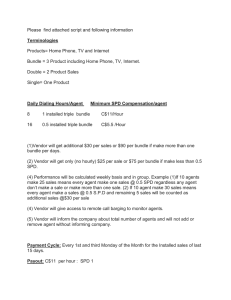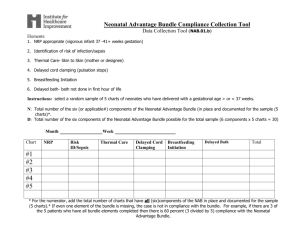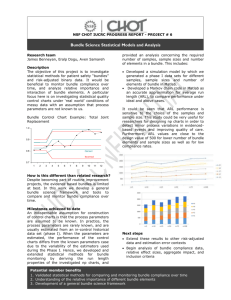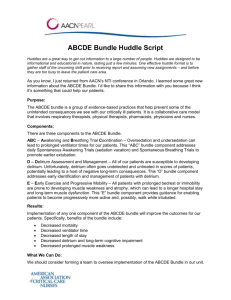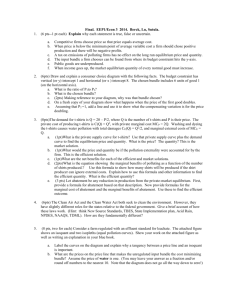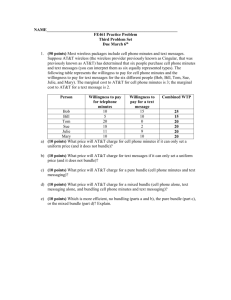Old Book Template
advertisement
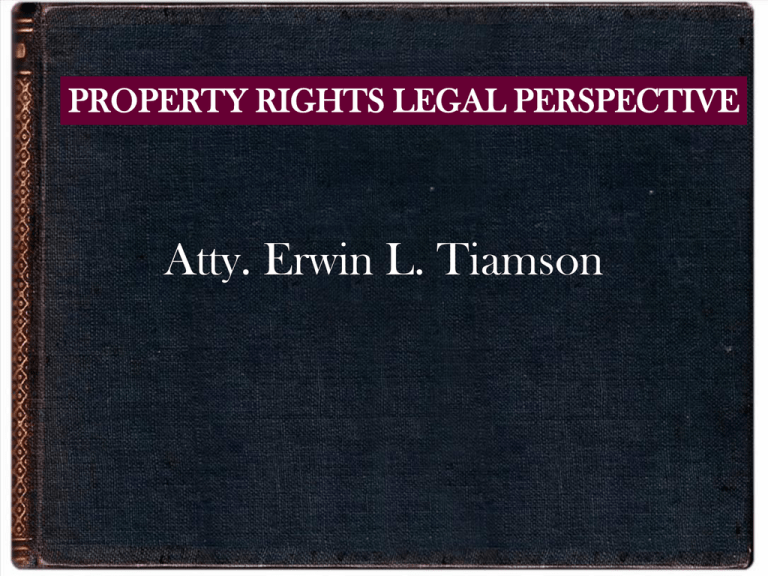
PROPERTY RIGHTS LEGAL PERSPECTIVE Atty. Erwin L. Tiamson Traditional Concepts and Definitions •This term is often used to signify any valuable right or interest protected by law and the subject matter or things in which rights or interest exists it is thus a creation of law, and is all its forms is a creature of the law. •Property rights are the rules provided by law that determine who gets or do what and who must compensate whom if damages occur. •Property means the right which a person has in relation to something as distinguished from the thing itself. Traditional Concepts and Definitions • It is the right of an individual to dominion over such things as permitted by the state such as right of possession, user, enjoyment, and disposition. •Not the Object, the Thing or the RES but the juridical tie by virtue of which, a person has the exclusive power to receive or obtain all the benefits from a thing, except those prohibited or restricted by law or the rights of others •However, the property itself, as a thing, could have a distinct and legal meaning. Sources of Property Rights Property rights, from a purely legal sense, are established by the State through: • Statues •“Legal Precedents” interpreting the laws. •Executive Implementation of the laws •Individuals through contracts and other binding agreements •Customs and Traditions recognized by the law Identifying Property Rights •In modern society and legal system, property includes practically all valuable rights and is indicative of wide range of interest which a person can have in either real or personal, corporeal or incorporeal, future or existing, divisible and indivisible, private or public property and other rights. •Includes the right to practice the profession, pursue lawful business, carry an occupation, right to labor and contract employment, right to terminate such employment, etc. Identifying Property Rights •Whether they are formal or informal, whether they apply to tangible or intangible assets, property rights consist of multiple characteristics often referred to by lawyers as a bundle of sticks, each of which represents a different aspect of property ownership. •These ownership characteristics include the right to use and enjoy, the right to exclude others, the right to transfer an asset to others and the right to just compensation, if the property is taken by the state in the exercise of its right of eminent domain. Property as Bundle of Rights •Blackstone's characterization - sole and despotic dominion in total exclusion of the right of any other individual. •Possibilities for a holder to act, reasonably undisturbed by other people. •In reality, it is often subject to limitations such as the general limitations for the benefit of the state, those by law by contract or last will by the owner himself and those arising from conflicts with other similar rights. Property as Bundle of Rights The bundle of rights is a common way to explain the complexities of property ownership between the title owner, third parties and the state. •Property rights are really relational and may vary according to actors or property rights holders exercising their particular rights. •Each individual is located within a matrix of property relationships with other property holders, including the state. Property as Bundle of Rights PROPERTY RIGHTS IS RELATIONAL • A land owner can legally refuse to sell his land to his neighbor or tenants but not to the state under a valid exercise of the power of eminent domain such as when his land is covered by agrarian reform laws. • Ordinarily prohibit his neighbor from entering his land by his right to exclude but not when the intrusion is necessary to avert an imminent danger or “acts of necessity. The owner is obliged by law to tolerate the act. Property as Bundle of Rights • In Great Britain the right of land owner to exclude is greatly diminished by the Countryside and Rights of Way Act of 2000 (CRoW) that gives right to walkers to cross private lands. •The rights emerged as an ethical obligation on the part of both the landowner – to allow access – and the visitor – to not disturb the landowner’s privacy or damage his land. Case in Point – Sta. Rosa Realty vs. Court of Appeals DAR issue CARP Coverage State Enacts Agrarian Reform DENR and Local Government Presented Evidence Land is Watershed & zoned as Park Court Issue Eviction Land Owner Files Ejectment in Court Tenants Petition DAR for CARP Coverage RIGHT TO EXCLUDE RIGHT OF EMINENT DOMAIN RIGHT OF AGRARIAN REFORM BENEFICIARY STATE/LOCAL RESTRICTION AS TO THE USE OF THE PROPERTY Supreme Court Upheld DAR’s Coverage COMPENSATION TO THE OWNER BY THE STATE Legal Definition of Thing Defining the physical and legal attribute of the “thing” is also important in understanding property relations because of its effect on the rights of the property holder. • Physical Attributes of things is different from its legal attributes. • The term “forest” or “watershed” in law for instance is descriptive of the legal nature or status of the land and not of its physical character. •Source of conflicts, i.e. Boracay Island Conclusion •The volume of the laws that are being enacted and the complex structure and ambiguities in its language, often leads to the multiple interpretation and unpredictable application of property relations. •The inclusion or exclusion of what can be considered as property rights, are mostly defined by legal precedents, the interpretation of the courts of the law with respect to a particular set of facts. •Property owners can never be fully certain if their actions or freedom to act is legitimate or within the bounds of the law, resolution though litigation in court. Conclusion •Courts however are designed to be reactive enforcers. Courts intervention to conflict in property relations begins only once another party has initiated legal proceedings. The courts do not initiate proceedings •As an effect, defining property rights are often left in the hands of the legal practitioners when drafting contracts and agreements between property holders or when partitioning the bundle of sticks, with the courts entering the fray only when conflict arises out of the said partitions or rebundling of rights Thank you!


